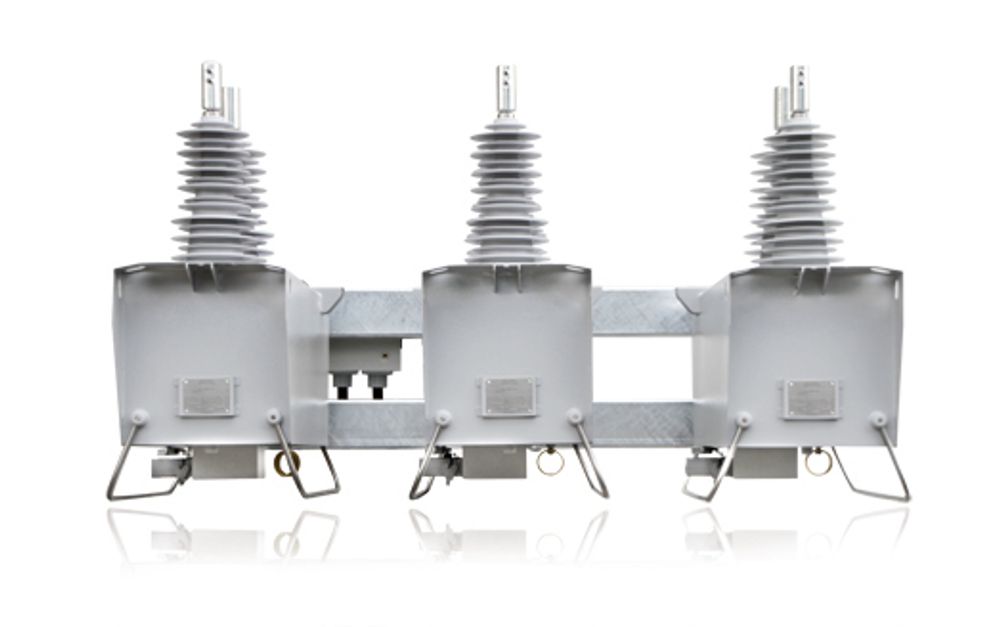Press Release
Published 03/2014
300 series single triple ACR from NOJA Power meets demands of U.S. electricity distribution sector
300 series single triple ACR from NOJA Power meets demands of U.S. electricity distribution sector

Electrical switchgear engineers NOJA Power today announces the release of its 300 series single triple Automatic Circuit Recloser (ACR). The 300 series single triple product is based on the company’s proven OSM38 single pole ACR combined with the comprehensively re-engineered RC-10 controller to meet the specific demands of the U.S. electricity distribution sector.
Units from NOJA Power's OSM range of medium-voltage (15, 27 and 38 kV) ACRs have been installed by utilities in over 80 countries around the world but the existing range is primarily designed for three-phase protection.
Distribution systems in Australia, Europe and South America employ three-wire, three-phase systems (with no neutral return) that cut off all downstream subscribers when the ACR isolates the feeder in the event of a fault. In contrast, the U.S. employs a three-phase electricity distribution system using four wires (the fourth being a neutral return) that can be split into single phases to supply typically 7 to 11 houses. The advantage of the system is that interruption of supply due to a fault typically affects only one phase, limiting the premises that are cut off.
The 300 series single triple ACR comprises three OSM38 single pole ACRs (see “About the NOJA Power single phase ACR” below)––normally used singly to protect single wire earth return (SWER) distribution lines used to service remote rural areas––mounted on a single bracket. The product offers coordinated individual ACR protection of each phase in the U.S. four-wire system all mounted on a single platform for simplified installation.
The OSM38 single pole ACR features a rated maximum system voltage of 38 kV and a rated continuous current of 800 A. Peak fault make capacity (RMS) is 12.5 kA and maximum impulse across the interrupter is 170 kV. Voltage can be measured on each bushing and current is measured on each phase of the ACR using capacitively-coupled voltage sensors and current transformers. The ACR’s voltage and current measurement eliminates the need for additional measurement equipment, decreasing costs and reducing the amount of pole-mounting space required.
The unit features a vacuum interrupt and solid dielectric insulator instead of the environmentally unfriendly oil or sulphur hexafluoride (SF6) gas used in older products. The ACR is housed in a stainless steel tank and is the only solid dielectric unit with controlled arc venting on the market. The controlled arc venting design is in accordance with the requirements of IEC62271-200 Clause 6.106 and Annex A, and the efficacy of this important safety feature has been tested and verified by independent test laboratories. The ACR has also been fully type-tested by independent laboratory KEMA in the Netherlands to ensure long life and reliability under the harshest environmental conditions.
The 300 series is controlled by a new version of NOJA Power’s RC-10 control and communications cubicle. The RC-10 is a SCADA-ready controller that provides a directional overcurrent, earth fault and sensitive earth fault relay, auto reclosing relay, instantaneous metering, event log, demand logger and RTU for remote control in a single package. A large backlit LCD display and keypad enable fast navigation and local control. The operator can use the LCD display to quickly switch between the operating parameters of the three ACRs making up the 300 series platform and the large size of the display ensures information is presented clearly without recourse to scrolling or reference to manuals.
NOJA Power’s suite of software tools automates the analysis of data captured by the company’s ACRs and associated RC-10 controllers allowing engineers to react quickly to problems on the network.
The ACR includes many features that underline its suitability for smart grid distribution automation. Chief among these are bidirectional protection capability and wide range of communication options within the RC-10 cubicle. The company’s ACRs can monitor and protect distribution lines in both directions as well as being set to trip at different current levels depending on the direction of electricity flow. In addition, the relay module inside the RC-10 has three USB ports, an Ethernet port and one RS232 port available for communication connections. The USB ports can be used with NOJA Power approved communications accessories to provide a wide range of port interfaces––such as RS485, RS232, Ethernet, Wi-Fi, GSM and GPRS modems––to remotely connect the configuration software for engineering access across serial, modem and Ethernet links.
“The 300 series single triple ACR is based on NOJA Power’s proven single pole recloser and therefore benefits from the inherent advantages of that unit such as stainless steel tank, solid dielectric and controlled arc venting,” explains David Dart, R&D Director of NOJA Power and IEEE C37.60 standard committee member. “Nonetheless, NOJA Power committed significant engineering resource to ensure all the key functionality from the single pole ACR was retained in the single triple product. It took significant engineering expertise to realign and test the electronic control systems and mechanical & electrical operation of the new product to ensure it could meet the demand of the U.S. market. The end product is a testament to that commitment.”
“The U.S. is a pioneer in using distribution automation to modernise the electricity distribution grid,” comments Neil O’Sullivan, Managing Director of NOJA Power. “We believe our ACRs are fundamental building blocks for such ‘smart grids’ so I’m pleased that, in the form of the 300 series single triple ACR, we now have a product that’s based on our independently tested- and proven-technology and meets the unique needs of the U.S. market.”
Want to stay up to date with Electrical Distribution Technology?
Join our list for a free weekly technical bulletin, as we share our Global Electrical Engineering experience directly to your inbox.
Subscribe →